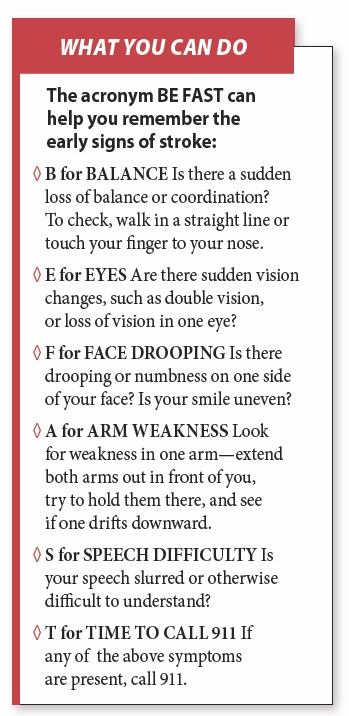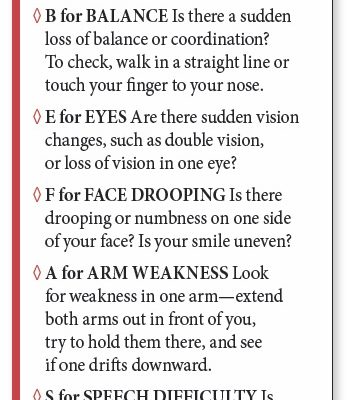Get Help Fast for Heart Attack and Stroke
Many people having a stroke or heart attack don’t know it. Lack of knowledge about the warning signs means they may dismiss a stroke as a bout of dizziness, while a heart attack might be chalked up to heartburn or a pulled muscle. However, if you ignore the symptoms that red-flag these serious cardiovascular events, you could condemn yourself to complications like heart failure (a major after-effect of heart attack), and physical or sensory disability (about two-thirds of stroke survivors have some disability, according to the National Stroke Association).
Heart Attack: Time is Muscle A heart attack occurs when a blockage forms in one of the coronary arteries. This stops blood flow to the heart, causing heart muscle cells in the affected area to die. “The longer you wait before seeking treatment, the more muscle you lose,” confirms Mount Sinai cardiologist Bruce Darrow, MD. “Even if the heart attack isn’t fatal, damaged heart muscle can impair the heart’s ability to pump. This results in congestive heart failure, which kills an estimated 26 percent of women and 19 percent of men within one year of their first heart attack.”
Symptoms to Take Seriously It is important to keep in mind that heart attack symptoms aren’t always obvious in older adults. In younger and middle-aged people, most heart attacks involve discomfort in the center of the chest—this may manifest as pressure, a squeezing sensation, or a feeling of fullness, and may last for more than a few minutes, or ease but then return. It also may radiate to one or both arms, or be felt in the back, neck, jaw, or stomach. But symptoms may be more subtle in older adults. “For example, you may suffer shortness of breath, dizziness, and nausea,” Dr. Darrow says, “and women especially may experience extreme fatigue, anxiety, a sense of impending doom, and cold sweats.”
If you suspect you may be having a heart attack, call 911 and chew a 325 milligram aspirin (if you are high-risk for heart attack, keep some handy). “Aspirin helps to prevent blood clots, and may help keep a coronary artery partially open,” Dr. Darrow explains. “The brand doesn’t matter, but it needs to be uncoated.”
Stroke: Time is Brain Ischemic stroke is the most common type of stroke, and happens if a fragment of a blood clot breaks off and travels, via the circulation, to the brain. “Once there, it blocks blood flow to the surrounding brain tissue,” says Deborah Horowitz. “Without oxygenated blood, the affected brain tissue starts to die, and the physical or sensory functions controlled by that area of the brain may be affected—for example, a stroke on the left side of the brain may result in vision loss and lasting muscle weakness or paralysis on your right side, while a stroke on your right side may result in hearing impairment and lasting muscle weakness or paralysis on your left side.” Stroke also can affect your memory (it is a risk factor for dementia in old age).
Getting fast medical treatment can help you avoid these severe complications, so try to get to the emergency department within three hours of noticing possible stroke symptoms. Once there, you can be given the clot-busting drug tissue plasminogen activator (tPA), which breaks up the blood clots that cause ischemic stroke. “While the drug may be effective for up to 4.5 hours after symptom onset, research suggests that the earlier you receive it, the better the outcome,” says Dr. Horowitz. “Surgical removal of a blood clot may be possible in people who don’t get tPA—however, this depends on how large and accessible the affected blood vessel is.”
Symptoms to Take Seriously Stroke symptoms develop suddenly, and may include a severe headache, numbness or weakness of the face, arm or leg (especially on one side), trouble speaking, confusion, and vision problems. You also may experience dizziness, and difficulty walking.
If you are high-risk for stroke, get informed about possible stroke symptoms (see What You Can Do), and make sure your family and friends are aware of them too. “Keep in mind that—unlike a heart attack, for example—a stroke doesn’t hurt,” Dr. Horowitz says. “This means you might not be aware you are having one unless you educate yourself about common symptoms.”

Know Your Risk Factors Ask your doctor if you are particularly vulnerable to heart attack and/or stroke, since this knowledge can give you the heightened awareness you need to act fast if symptoms strike. Unfortunately, age raises the risk for both events, and isn’t something you can change. Other converging risk factors include smoking, obesity, atherosclerosis (narrowed arteries), and high blood pressure, cholesterol, and diabetes. A major risk factor for stroke alone is atrial fibrillation (Afib): an abnormal heart rhythm that causes blood to clot in the heart’s upper chambers. A stroke can result if a clot dislodges and lands in a blood vessel leading to the brain.
You can mitigate most of these risk factors by following a healthful diet that is high in fruits, vegetables, whole grains and healthy fats (the Mediterranean diet is ideal), getting plenty of exercise (take a brisk, 30-minute walk each day), and watching your weight. You also should quit smoking, and follow your doctor’s advice for controlling high blood pressure, cholesterol, and blood sugar.
Always Call 911 If you suspect you are having a heart attack or stroke, call 911—don’t drive yourself to the hospital, since you could injure others (and yourself) if you lose control of your vehicle. Calling 911 also ensures that you can be cared for by emergency medical technicians (EMTs) en-route to the hospital. “If a heart attack is suspected, EMTs can perform an electrocardiogram to assess the extent of any possible heart damage, and notify the hospital to have the appropriate equipment standing by,” Dr. Darrow says.
“They also can perform CPR or use a defibrillator in the case of cardiac arrest.”
If you have suffered a stroke, the EMTs can arrange for you have a computed tomography (CT) scan immediately after your arrival at the hospital. “A CT scan is a vital first step in stroke treatment because it establishes whether a stroke is caused by a blood clot or bleeding in the brain,” Dr. Horowitz explains. “If it’s the latter, it would not be advisable to give tPA, since it thins the blood, and would exacerbate bleeding.”
The post Get Help Fast for Heart Attack and Stroke appeared first on University Health News.
Read Original Article: Get Help Fast for Heart Attack and Stroke »


